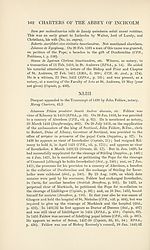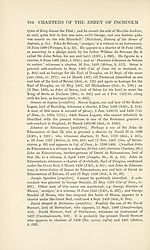Series 3 > Charters of the Abbey of Inchcolm
(216) Page 163
Download files
Complete book:
Individual page:
Thumbnail gallery: Grid view | List view

NOTES
163
(Coldingham, 255), and his commissioner, according to a papal letter of
16 Dec. 1448 (CPB., x. p. 397). On 10 Aug. 1447 and 6 May 1448, he
appears as rector of St. Andrews University (Cartae Variae, GRH., p. 224 ;
REB., i. 118); and, on 3 Aug. 1457, he was dean of the Faculty of Decrees
(Acts of the Faculty of Arts, quoted Copiale, p. 460). He was a nephew of
William Bowar, canon of the Priory, and obtained land from him, 8 Aug.
1434 (Copiale, p. 460). Feldew was apparently a relative, perhaps a cousin,
of Abbot Walter Bower; and this may account for his present employ¬
ment as notary. For his public career, see Copiale, p. 460, of which the
present note is largely an extension.
Guillelmi et Patricii . . . monasteriorum de Dunfermlyn et de Cambus-
keneth . . . abbatum. ‘ William de Sancto Andrea,’ says the Preface to the
Registrum de Dunfermelyn (p. Ixv.), ‘ was Abbot of Dunfermline in 1414
and 1419, of whom nothing is known but his name.’ He occurs twice
in the Dunfermline register (401, 402), but other information regarding
him is forthcoming. In 1416, Robert de Doles, monk of Dunfermline,
petitions the Pope for the priory of Urquhart, void by the promotion of
William de Sancto Andrea to Dunfermline (CPR., Petitions, i. p. 605).
According to a papal ‘concessio’ of 20 March 1419, William de Sancto
Andrea was provided by Peter de Luna (the anti-Pope Benedict XIII)
and took over the rule and administration of the monastery ; his election
was challenged by Robert de Scotland, formerly claustral prior and
abbot-elect (Supplies., p. 25). On 22 May of the same year, the Pope
grants a petition of William, Abbot of Dunfermline, for a new provision
to the monastery which he has ruled for three years. He was formerly
a monk of Dunfermline (i.e. before becoming Prior of Urquhart, which
was a cell of Dunfermline) and succeeded Abbot John (Supplies., p. 53).
On 22 May 1420, William de Restoun, monk, is a conspirator against
Abbot William (ibid., p. 199). William grants a charter, along with his
convent, in 1422 and is a party to an instrument, 23 May of that year
(Cambuskenneth, 102, 103). He appears in a papal letter, 4 Jan. 1423
(CPR., vii. p. 290), is a witness on 27 May 1425 (REG., ii. 325) and appears
also, 17 March 1425 (No. xlvi. infra). He was dead before 1442 (CPR.,
ix. p. 271). Patrick was Abbot of Cambuskenneth from 1400 to a. 1440
(Cambuskenneth, pp. lviii.-lx.). He is one of the abbots witnessing an
exemplification of the charters of Edward 1,17 March 1415 (REG., ii. 325).
Patrick of Callendar, Abbot of Cambuskenneth, witnesses a charter,
26 Jan. 1425 {Wigtown Charter Chest, 714).
Walterum . . . abbatem monasterii S. Columbe. Walter Bower.
See Appendix iv.
Johanne de Setoun milite domino eiusdem. ‘ Johne Seytoun succeedit
to Lord Williame his fader and was ane nobill man and maister [of the]
houshald to King James the First. Be quham he was send to France
wyth his dochter, quha was mariet on the Daulphin of France, Lewis the
Elewint. Efter the said Johne come hame agane, he levit honestlie
certane yeiris and syne deyt and [was] bureit in the paroche kirk of
Seytoun, in the yle foundit be his moder. This Lord Johne was in the
163
(Coldingham, 255), and his commissioner, according to a papal letter of
16 Dec. 1448 (CPB., x. p. 397). On 10 Aug. 1447 and 6 May 1448, he
appears as rector of St. Andrews University (Cartae Variae, GRH., p. 224 ;
REB., i. 118); and, on 3 Aug. 1457, he was dean of the Faculty of Decrees
(Acts of the Faculty of Arts, quoted Copiale, p. 460). He was a nephew of
William Bowar, canon of the Priory, and obtained land from him, 8 Aug.
1434 (Copiale, p. 460). Feldew was apparently a relative, perhaps a cousin,
of Abbot Walter Bower; and this may account for his present employ¬
ment as notary. For his public career, see Copiale, p. 460, of which the
present note is largely an extension.
Guillelmi et Patricii . . . monasteriorum de Dunfermlyn et de Cambus-
keneth . . . abbatum. ‘ William de Sancto Andrea,’ says the Preface to the
Registrum de Dunfermelyn (p. Ixv.), ‘ was Abbot of Dunfermline in 1414
and 1419, of whom nothing is known but his name.’ He occurs twice
in the Dunfermline register (401, 402), but other information regarding
him is forthcoming. In 1416, Robert de Doles, monk of Dunfermline,
petitions the Pope for the priory of Urquhart, void by the promotion of
William de Sancto Andrea to Dunfermline (CPR., Petitions, i. p. 605).
According to a papal ‘concessio’ of 20 March 1419, William de Sancto
Andrea was provided by Peter de Luna (the anti-Pope Benedict XIII)
and took over the rule and administration of the monastery ; his election
was challenged by Robert de Scotland, formerly claustral prior and
abbot-elect (Supplies., p. 25). On 22 May of the same year, the Pope
grants a petition of William, Abbot of Dunfermline, for a new provision
to the monastery which he has ruled for three years. He was formerly
a monk of Dunfermline (i.e. before becoming Prior of Urquhart, which
was a cell of Dunfermline) and succeeded Abbot John (Supplies., p. 53).
On 22 May 1420, William de Restoun, monk, is a conspirator against
Abbot William (ibid., p. 199). William grants a charter, along with his
convent, in 1422 and is a party to an instrument, 23 May of that year
(Cambuskenneth, 102, 103). He appears in a papal letter, 4 Jan. 1423
(CPR., vii. p. 290), is a witness on 27 May 1425 (REG., ii. 325) and appears
also, 17 March 1425 (No. xlvi. infra). He was dead before 1442 (CPR.,
ix. p. 271). Patrick was Abbot of Cambuskenneth from 1400 to a. 1440
(Cambuskenneth, pp. lviii.-lx.). He is one of the abbots witnessing an
exemplification of the charters of Edward 1,17 March 1415 (REG., ii. 325).
Patrick of Callendar, Abbot of Cambuskenneth, witnesses a charter,
26 Jan. 1425 {Wigtown Charter Chest, 714).
Walterum . . . abbatem monasterii S. Columbe. Walter Bower.
See Appendix iv.
Johanne de Setoun milite domino eiusdem. ‘ Johne Seytoun succeedit
to Lord Williame his fader and was ane nobill man and maister [of the]
houshald to King James the First. Be quham he was send to France
wyth his dochter, quha was mariet on the Daulphin of France, Lewis the
Elewint. Efter the said Johne come hame agane, he levit honestlie
certane yeiris and syne deyt and [was] bureit in the paroche kirk of
Seytoun, in the yle foundit be his moder. This Lord Johne was in the
Set display mode to:
![]() Universal Viewer |
Universal Viewer | ![]() Mirador |
Large image | Transcription
Mirador |
Large image | Transcription
Images and transcriptions on this page, including medium image downloads, may be used under the Creative Commons Attribution 4.0 International Licence unless otherwise stated. ![]()
| Scottish History Society volumes > Series 3 > Charters of the Abbey of Inchcolm > (216) Page 163 |
|---|
| Permanent URL | https://digital.nls.uk/128323367 |
|---|
| Attribution and copyright: |
|
|---|
| Description | Over 180 volumes, published by the Scottish History Society, containing original sources on Scotland's history and people. With a wide range of subjects, the books collectively cover all periods from the 12th to 20th centuries, and reflect changing trends in Scottish history. Sources are accompanied by scholarly interpretation, references and bibliographies. Volumes are usually published annually, and more digitised volumes will be added as they become available. |
|---|


